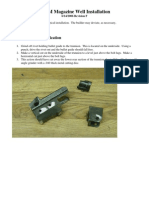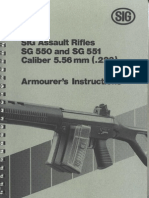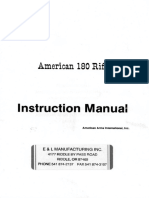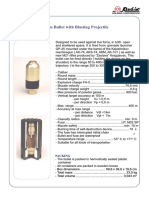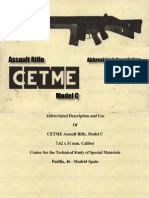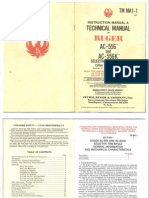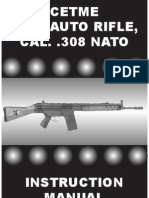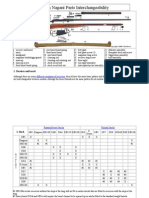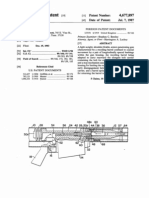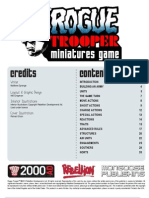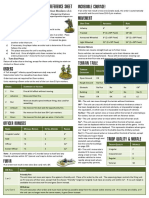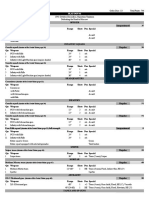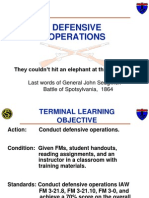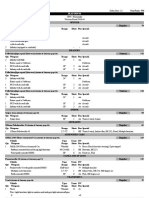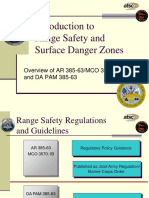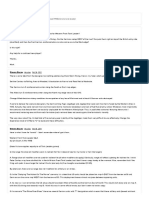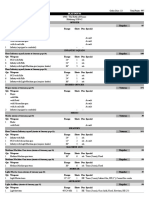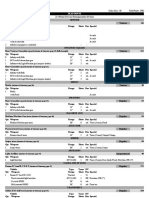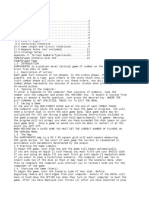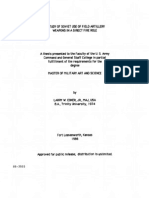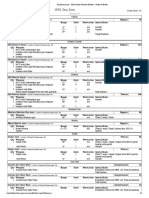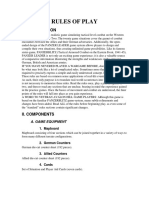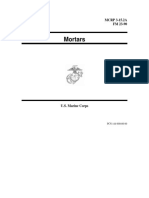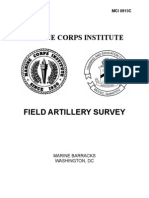40-Mm Grenade Launcher, M79: A-1. Description
40-Mm Grenade Launcher, M79: A-1. Description
Uploaded by
Piet1111Copyright:
Available Formats
40-Mm Grenade Launcher, M79: A-1. Description
40-Mm Grenade Launcher, M79: A-1. Description
Uploaded by
Piet1111Original Title
Copyright
Available Formats
Share this document
Did you find this document useful?
Is this content inappropriate?
Copyright:
Available Formats
40-Mm Grenade Launcher, M79: A-1. Description
40-Mm Grenade Launcher, M79: A-1. Description
Uploaded by
Piet1111Copyright:
Available Formats
APPENDIX A
40-MM GRENADE LAUNCHER, M79
This appendix provides guidance for US Army units to conduct training with the M79 grenade launcher. The weapons characteristics, disassembly and assembly procedures, maintenance, sights, opertion and function, marksmanship training, firing positions, indirect-fire role, and safety precautions are discussed. A-1. DESCRIPTION The M79 grenade launcher is a single-shot, break-open, breech-loading, shoulder-fired weapon (Figure A-1). It consists of a receiver group, fore-end assembly, barrel group, sight assembly, stock assembly, and sling. A rubber recoil pad is attached to the butt of the stock to absorb some of the recoil.
A-1
FM 23-31
A-2. TECHNICAL DATA Technical data for the M79 grenade launcher areas follows: a. Weapon. Length Launcher (overall) . . . . . . . . . . . . . . . . . . . . . . . . . . . . . . . . . . . . . . . . . . . 73.70 cm (29 inches) Barrel group. . . . . . . . . . . . . . . . . . . . . . . . . . . . . . . . . . . . . . . . . . . . . . . . . . 38.10 cm (l5 inches) Barrel only. . . . . . . . . . . . . . . . . . . . . . . . . . . . . . . . . . . . . . . . . . . . . . . . . . . . 35.60 cm (l4 inches) Weight Unloaded . . . . . . . . . . . . . . . . . . . . . . . . . . . . . . . . . . . . . . . . . . . . . . . . . . . . . . 2.72 kg (6.0 pounds) Loaded. . . . . . . . . . . . . . . . . . . . . . . . . . . . . . . . . . . . . . . . . . . . . . . . . . . . . . . . 2.95 kg (6.5 pounds) b. Ammunition. Caliber . . . . . . . . . . . . . . . . . . . . . . . . . . . . . . . . . . . . . . . . . . . . . . . . . . . . . . . . . . . . 40 mm Weight . . . . . . . . . . . . . . . . . . . . . . . . . . . . . . . . . . . . . . . . . . . . . . . . . . . . . . . . . . . . . 227 grams (8 ounces) c. Operational Characteristics. Action . . . . . . . . . . . . . . . . . . . . . . . . . . . . . . . . . . . . . . . . . . . . . . . . . . . . . . . . . . . . . . Break-open, single shot Sights: Front. . . . . . . . . . . . . . . . . . . . . . . . . . . . . . . . . . . . . . . . . . . . . . . . . . . . . . . . . . . . Blade-type Rear. . . . . . . . . . . . . . . . . . . . . . . . . . . . . . . . . . . . . . . . . . . . . . . . . . . . . . . Folding leaf-type, adjustable Chamber pressure . . . . . . . . . . . . . . . . . . . . . . . . . . . . . . . . . . . . . . . . . . . . 17.685 kilopascals (3,000 pounds psi) Muzzle velocity. . . . . . . . . . . . . . . . . . . . . . . . . . . . . . . . . . . . . . . . . . . . . . . . . . 76 mps (250 fps) Maximum range . . . . . . . . . . . . . . . . . . . . . . . . . . . . . . . . . . . . . . . . . . . . . . . . . 400 meters (1,312 feet) Maximum effective range Area target. . . . . . . . . . . . . . . . . . . . . . . . . . . . . . . . . . . . . . . . . . . . . . . . 350 meters (1,l48 feet) Point target . . . . . . . . . . . . . . . . . . . . . . . . . . . . . . . . . . . . . . . . . . . . . . . . . . 150 meters (492 feet) Minimum safe firing range: Training. . . . . . . . . . . . . . . . . . . . . . . . . . . . . . . . . . . . . . . . . . . . . . . . . . . 130 meters (426 feet) Combat . . . . . . . . . . . . . . . . . . . . . . . . . . . . . . . . . . . . . . . . . . . . . . . . . . . . . . . . .31 meters (102 feet) A-3. COMPONENTS The major components of the 40-mm grenade launcher are shown in Figure A-2. The front and rear sights, the safety, the trigger and trigger guard A-2
FM 23-31
detent assembly, and the barrel locking latch and lever are shown in Figure A-3 through Figure A-8.
a. Rear Sight Assembly. Figure A-3 shows the adjustable rear sight assembly, which consists of a rear sight lock, a windage screw and windage scale, an elevation scale and lock screw, a sight carrier and retainer locknut, an elevating screw wheel and elevating screw, and a rear sight frame with freed leaf sight. To align the rear sight with the front sight, adjust the ladder on the rear sight. (1) Rear sight lock. This lock is spring-loaded, so you can lock the rear sight frame assembly either in the UP or DOWN position. To unlock the sight frame, push down on the flat surface of the rear sight lock. To relock the sight frame, release the pressure once the frame is in the desired position. (2) Windage screw and windage scale. To adjust the rear sight for deflection, turn the knob on the right end of the windage screw. A-3
FM 23-31
screw. One click moves the impact of the grenade about 28 cm (11 inches) at a range of 200 meters. To adjust for right windage, turn the screw clockwise; for left windage, turn it counterclockwise. The windage scale has a zero line in its center and ten equally-spaced lines on each side of the zero line. You can move the rear sight assembly as much as 42 clicks right or left of center. (3) Elevation scale and lock screw. The elevation scale is graduated from 75 to 375 meters in 25-meter increments and numbered at 100, 200, 300, and 375 meters. As you move the rear sight carrier up the adjustable elevation scale, the rear sight cams to the left to compensate for the normal right-hand drift of the projectile. The lock screw holds the elevation scale in position. (4) Sight carrier retainer locknut. Position and clamp the carrier to the sight frame in the desired position on the elevation scale. Turn the retainer locknut counterclockwise until you can push it inward. The inward pressure unlocks the sight carrier, which allows you to move it along the elevation scale. To lock the sight carrier in position, release the pressure on the retainer locknut, and turn the nut clockwise until it stops. (5) Elevating screw wheel and elevating screw. Use the elevating screw and screw wheel to make fine adjustments in elevation. Turn the wheel clockwise to increase the elevation setting, counterclockwise to decrease it. Turning the screw moves the sight carrier along the elevation scale. One complete turn (one click) moves the impact of the round about 2 1/2 meters at a range of 200 meters. (6) Rear sight frame with fixed sight. When the rear sight frame is in the DOWN position, use the fixed sight to engage targets up to 100 meters away. Sight. b. F r o n t Figure A-4 shows the stationary front sight, which has a tapered blade and two blade guards. c. Safety. To fire the launcher, ensure the safety is positioned forward (A, Figure A-5), with the letter "F" visible near the rear of the safety. It will not fire if the letter S is visible. The safety A-4
FM 23-31
automatically engages when you unlock the barrel locking latch and open the breech (B, Figure A-5).
d. Trigger and Trigger Guard Detent Assembly. Figure A-6 shows the locations of the trigger and trigger guard. Depress the detent assembly to move the trigger guard right or left, or to fire when wearing gloves or mittens.
A-5
FM 23-31
e. Barrel Locking Latch and Leveer. Figure A-7 shows the barrel locking latch on top of the receiver. This latch locks the barrel to the receiver together. To open (break) the breech end of the barrel, press the latch lever all the way to the right.
A-4. AMMUNITION The M79 grenade launcher uses standard M203 grenade launcher ammunition, which is issued IAW unit SOP. A-5. CLEARING PROCEDURE Clearing the weapon is always the first step in performing maintenance or handling. a. Place the weapon on SAFE. b. Rotate the barrel locking lever fully to the right. c. Open the barrel. d. Inspect the breech to ensure it is clear (no round is present). e. Return the barrel to the firing position. A-6. GENERAL DISASSEMBLY The grenadier places each part he removes on a clean, flat surface, such as a table, shelter half, or disassembly mat, in the order they are removed. This helps in reassembly. NOTE: Ordnance personnel must disassemble the weapon beyond the level described in this paragraph. a. Remove the sling from the stock. A-6
FM 23-31
b. Remove the retaining band screw, which passes through the rear the front sling swivel mount, and pull the fore-end assembly away from the barrel (Figures A-8 and A-9).
A-7
FM 23-31
c. Press the barrel locking latch lever to the right, and pivot the barrel down until it stops; slide the barrel off the fulcrum pin, and remove it from the receiver (Figure A-10). Do not remove the rear sight from the barrel.
d. Remove the stock screw and washers, and pull the stock rearward from the receiver (Figure A-11).
A-8
FM 23-31
A-7. CLEANING AND LUBRICATION The grenadier cleans and lubricates the M79 grenade launcher the same as he would the M203 grenade launcher. (TM 9-1010-205-10 lists the tools and equipment required.) A-8. GENERAL ASSEMBLY The grenadier should assemble the grenade launcher in the reverse order in which he disassembled it (Figure A-12). a. Place the lock washer on the stock screw, and install the stock on the receiver. b. Place the barrel on the fulcrum pin. Hold the cocking lever up, lower the barrel, and ensure that the cocking arm slides under the cocking lever. Close the barrel. c. Place the fore-end assembly on the barrel, and secure it by replacing the retaining band screw. d. Replace the sling.
A-9. CARE AND HANDLING Proper maintenance of the M79 grenade launcher is vital and must be part of all gunnery training programs. Good maintenance contributes to weapon effectiveness as well as to unit readiness. Maintaining the weapon includes clearing, disassembling, cleaning, lubricating, and inspecting it, and checking its assembly and functions. A-9
FM 23-31
A-10. OPERATION AND FUNCTION Operations include loading, unloading, and firing the weapon, which uses a high-low propulsion system to fire a round. The firing pin strikes the primer, whose flash ignites the propellant in the brass powder-charge cup inside the high-pressure chamber. The burning propellant produces 35,000 psi chamber pressure, which ruptures the brass powder-charge cup at the vent holes. This allows the gases to escape to the low-pressure chamber in the cartridge case, where the pressure drops to 3,000 psi and propels the grenade from the muzzle at a velocity of 250 fps. The grenades 37,000 rpm right-hand spin stabilizes the grenade during flight and applies enough rotational force to arm the fuze. The grenadier loads and unloads the weapon with the barrel open, and fires it from a closed bolt. The launcher must be cocked before it can be placed on SAFE. a. Loading. To load the weapon (Figure A-13) (1) Move the barrel locking latch as far to the right as possible. (2) Insert a round into the chamber, ensuring the extractor contacts the cartridge case rim. (3) Close the weapon. (4) Place the weapon on SAFE.
A-10
FM 23-31
WARNING KEEP THE MUZZLE POINTED DOWNRANGE AND CLEAR OF ALL SOLDIERS. USE THE CORRECT AMMUNITION; NEVER USE HIGH-VELOCITY 40-MM AMMUNITION.
b. Unloading. To unload the weapon (Figure A-14) (1) Place the weapon on safe by moving the barrel locking latch as far right as possible. (2) If the cartridge case is partially extracted, remove the cartridge case. If the cartridge case is not partially extracted, engage the extractor tang and pull it rearward. (3) Grasp the cartridge case and remove it.
WARNING IF THE WEAPON HAS NOT BEEN FIRED, AVOID DETONATION BY EITHER CATCHING THE EJECTED ROUND OR BY HOLDING THE WEAPON CLOSE TO THE GROUND TO REDUCE THE DISTANCE THE ROUND COULD FALL.
A-11
FM 23-31
A-11. CYCLE OF FUNCTIONING Grenadiers can recognize and correct a stoppage if they understand how the weapon functions. The loading and firing of a round and the resulting effect on the parts of the weapon are referred to as the cycle of functioning. Many of the actions in this cycle occur at the same time and are separated here only to explain them more clearly. a. Unlocking. Before you can unlock the barrel from the receiver and move the safety to the SAFE position, you must press the barrel locking latch lever all the way to the right, so spring-loaded latch lock holds the barrel locking latch open (Figure A-15).
b. Cocking. Opening the barrel cocks the weapon by causing the cocking arm to lift the cocking lever. The cocking lever rotates around the hammer pin until it contacts a stud on the hammer. Then the lever rotates upward with the hammer until the sear engages the sear notch, cocking the weapon. c. Extracting. This occurs while you are cocking the weapon (Figure A-16). As you open the barrel, the spring-loaded extractor withdraws the spent cartridge case about 1/2 inch from the breech end of the barrel. A-12
FM 23-31
d. Ejecting. The M79 grenade launcher does not eject rounds automatically; remove the expended cartridge case or live round from the barrel (Figure A-17). e. Loading. With the barrel in the open position, insert the cartridge into the breech end of the barrel (Figure A-17).
A-13
FM 23-31
f. Chambering. Closing the barrel forces the extractor into the extractor housing, which causes the cartridge to seat in the chamber. g. Locking. Closing the barrel also depresses the latch lock, which rotates until it locks the barrel to the receiver (when it engages the barrel locking lug). To fire the weapon, push the safety forward to expose the letter F. h. Firing. AS you pull the trigger rearward, it rotates on the trigger pin. The rear of the trigger lifts the rear of the sear, causing the nose of the sear to disengage from the sear notch in the hammer. This releases the spring-driven hammer, which strikes the firing pin and drives it forward to strike the primer of the cartridge. When you release the trigger, the hammer settles back slightly, allowing the firing pin spring to withdraw the pin from the face of the retainer (Figure A-18).
A-12. PERFORMANCE PROBLEMS AND DESTRUCTION Performance problems and destruction procedures for the M79 grenade launcher are the same as for the M203 grenade launcher. A-14
FM 23-31
A-13. MARKSMANSHIP Marksmanship training teaches the grenadier to fire the grenade launcher and prepares him to employ it in combat. Except for the subjects discussed in the remainder of this appendix, marksmanship training, range construction, and range firing are the same for the M79 grenade launcher as they are for the M203 grenade launcher. a. Sight Alignment, Sight Picture, and Sight Manipulation. Sight alignment is the relationship between the front sight blade and the rear sight notch. Figure A-19 shows the correct sight alignment. If you drew an imaginary horizontal line across the top of the rear sight notch, the top of the front sight blade would touch the line. If you drew an imaginary vertical line through the center of the notch, the line would cut the front sight blade in half. Sight picture includes sight alignment and the placement of the aiming point (Figure A-20). Sight manipulation means placing the rear sight carrier at the setting on the elevation scale that corresponds to the range to the target.
b. Positions. Firing positions for the M79 grenade launcher are the same as for the M203 grenade launcher. The ones you are most likely to use are the prone, kneeling, fighting, and standing positions. When you have an option, always use the more stable supported positions. Using the M79 in firing positions differs from using the M203 in the following ways: (1) Assume firing positions the same as you would with your service rifle, but hold your right thumb against the right side of the grenade launchers stock. If you place this thumb over the small of the stock, the safety can injure your thumb, and you wont achieve a spot weld with the grenade launcher. A-15
FM 23-31
(2) Several actions are common to all the firing positions for the M79 grenade launcher: (a) Rest the launcher across the heel of your left hand, in the V formed by your left thumb and forefinger. (b) Relax the fingers of your left hand, and place your hand so that the upper sling swivel cannot pinch it. (c) Keep your left wrist straight, with your left thumb resting against the fore-end assembly not on the rear sight base. If you place your thumb near the rear sight base, your thumb could be injured when you fire the weapon. (d) Place your left elbow under the launcher. (e) Position your right elbow far enough to the right to level your shoulders and far enough forward to form a good pocket for the butt of the launcher. (f) Rest the thumb of your right hand along the side of the stock. WARNING DO NOT PLACE YOUR THUMB OVER THE SMALL OF THE STOCK, AS THE SAFETY COULD INJURE YOUR THUMB WHEN THE LAUNCHER RECOILS.
(g) Place your trigger finger on the trigger so that your finger and the side of the stock do not touch. A-16
FM 23-31
(h) Regardless of the firing position you have chosen, try to relax. (3) At ranges less than 150 meters, you can fire normally from your shoulder in any position. However, to maintain sight alignment at greater ranges, lower the position of the stock on your shoulder or drop the butt from your shoulder. At near-maximum ranges, you must position the stock between your waist and your armpit and hold the stock firmly against your body with your upper arm. In the prone position, once the stock is no longer against your shoulder, rest the butt of the launcher on the ground. Be careful to keep your head level when your cheek breaks contact with the stock. Figure A-21 shows the changes that occur as the range to the target increases.
(4) When pinpoint accuracy is not required, use the pointing technique to deliver a high rate of HE fire (Figure A-22). With the pointing technique, use a modified underarm firing position, keep both eyes open, and concentrate on the target, without using the sights. Keep the muzzle of the launcher in position so you can easily adjust your fire. This technique is most useful in an assault, because it allows you to reload rapidly with your left hand. However, you can use it in any standard firing position. A-17
FM 23-31
c. Zeroing ProceYou have dure. achieved a correct zero for a given range when your elevation and windage settings enable you to hit the point of aim. To zero the M79 grenade launcher, engage a target at 200 meters. This range allows you the most flexibility to adjust elevation. (1) Place the rear sights center index line on the windage scales center mark. (2) Unlock the elevation scale by turning its lock screw counterclockwise. Position the top of the scale flush with the top of the sight frame, and relock the scale. To unlock the rear sight carrier. turn and push the locknut that retains it. Slide the carrier along the elevation scale until the 200-meter index on the scale aligns with the top edge of the sight carrier. Relock the rear sight carrier. (3) Assume a prone supported position, and align the target with the front and rear sights, using correct sighting and aiming procedure. (4) Fire a round, sense the impact of the grenade, and adjust the sight. (a) Elevation. Turn the elevation screw wheel clockwise to increase the range, and vice versa. At a range of 200 meters, one click on the wheel moves the impact of the grenade 2 1/2 meters. (b) Windage. Turn the windage knob clockwise to move the impact of the grenade to the right, and vice versa. At a range of 200 meters, one click on the knob moves the impact of the grenade about 11 inches. (5) Fire two more rounds, and adjust after each. If the last round landed within 5 meters of the target, the weapon is correctly zeroed. (6) After confirming the zero, move the elevation scale so that the 200-meter index line is flush with the top of the sight carrier. A-18
FM 23-31
d. Indirect-Fire Role. Although the M79 grenade launcher is designed for direct fire, it can be used to place HE fragmentation fire on area targets that cannot be observed. (1) Employment. The accuracy of the weapon is limited in the indirect-fire role. Adjust the range, in 25-meter increments, to a maximum range of about 400 meters. (2) Sighting system. The standard sight assembly is graduated up to 375 meters, which corresponds to a 32-degree elevation. However, you can raise the rear sight carrier to increase elevation to up to 40 degrees. The rear sight cannot be used at greater elevations. The most accurate way to fire the M79 grenade launcher in the indirect-fire mode is to attach an M15 rifle grenade sight to the weapons stock (Figure A-23). This sight consists of a mounting scale plate and sight bar assembly.
(a) Installing the M15 sight. To prevent the wood in the launchers stock from cracking when the sight is installed, hold the sight against the stock and mark the positions for the screws. Drill two pilot holes. Use two short wood screws, and attach the mounting plate to the side of the stock. Ensure they do not protrude through the stock, or disassembling the weapon will be difficult. (b) Adjusting the M15 sight. Once you attach the M15 sight to the M79 grenade launcher, you will no longer need to use the mounting plates degree scale. Place a short piece of masking tape on the stock above the mounting plate. Adjust your fires until the rounds impact at the desired range. After you determine the sight setting, draw a line on the tape along the top of the sight A-19
FM 23-31
bar. Label each line for the appropriate range. Fire several rounds to determine the M15 sight elevation graduation required to fire the desired range. Mark this graduation on the stock for quick reference. (c) Using the M15 sight. Align the launcher for deflection. Assume a correct firing position, sight over or along the barrel, and move the launcher to align the barrel toward the target. Ensure the weapon is not canted. Raise or lower the muzzle to center the leveling bubble and determine the angle of elevation. If you have enough light, using the M15 sight is the quickest, easiest way to determine the proper angle of elevation. (3) Adjustments for elevation and deflection. To bring indirect-fire rounds nearer the target, move the barrel slightly for elevation or deflection. (a) Elevation. Estimate the range to the target and move the barrel either up or down. Table A- 1 provides guidelines to help you set the proper elevation.
(b) Deflection. Sight over or along the barrel at an aiming point. To increase the accuracy of indirect fire, place a string or straight stick on the ground in line with an aiming point or stake. (4) Ammunition. Because live ammunition must be conserved during both training and combat, TP rounds are used for training and zeroing. A TP round emits a puff of orange or yellow smoke on impact, which will help you adjust fire. TP rounds produce little fragmentation, which reduces the possibility of a training injury. Firing any 40-mm grenade launcher round in the indirect-fire role doubles the time required for the round to reach the target. This allows wind, snow, and rain twice the time to push the projectile off its normal trajectory. Before firing, you must evaluate and compensate for the wind, whether it is a crosswind or whether it is blowing on the same axis as the grenade. This evaluation (referred to as Kentucky windage) increases the chance of a first-round hit and reduces the chance that a round will impact closer to you than desired. Be careful when a wind of 5 mph or more is blowing from the direction of the target. Consider this particular wind condition when fining A-20
FM 23-31
at all ranges, but remember that it presents the greatest danger at the minimum indirect fire range of 200 meters. (5) Fire control. You may fire indirectly only when you receive a specific command to do so. (a) Fire commands for indirect fire differ from those for direct fire only in that, right after the target and range are designated, INDIRECT FIRE is given as as the method of employment. The following is an example indirect-fire command: GRENADIER FRONT INDIRECT FIRE, 3 ROUNDS TROOPS IN OPEN AT MY COMMAND (b) If the indirect-fire target is not visible from where you are, the squad leader may employ an observer. (c) Grenade launcher fire-for-effect should always consist of three to five rounds, depending on the nature of the target. e. Firing Positions for Indirect Fire. You may fire the M79 grenade launcher indirectly from the kneeling, sitting, or squatting position. (1) Kneeling. The kneeling position for indirect fire is about the same as for direct fire (Figure A-24). (a) Face the target and kneel on your right knee (if you are firing right-handed), keeping your left foot pointed in the direction of the target. (b) Sit on your right heel and place your left elbow outside your left knee. (c) Place the butt of the stock on the ground against or alongside your right knee. A-21
FM 23-31
(d) With your left hand, grasp the launcher near the upper sling swivel. With your right, grasp the small of the stock. Your right thumb should be parallel to your trigger finger and against the right side of the stock. The weight of your body should rest on your right heel. (2) Sitting. The sitting position for indirect fire is about the same as for direct fire. Use this position with aiming stakes or with the M15 sight (Figure A-25). (a) Keep your right leg flat on the ground and pointed at the target, crossing your left leg over your knee so your left knee supports your left elbow. (b) Place the butt of the stock alongside your right hip. (c) Hold the weapon as described for the indirect-fire kneeling position. (3) Squatting. This is the least comfortable indirect-fire position to remain in for any length of time. It is identical to the direct-fire modified squatting position, except for one difference: place the weapon between your knees, with the butt of the stock on the ground (Figure A-26). Hold the launcher as described for the kneeling position. Use aiming stakes or the M15 sight with this position. A-22
FM 23-31
f. Methods of Indirect Fire. Three methods may be used to fire the M79 grenade launcher indirectly. (1) Marked-sling method. This is the most field-expedient method. Loosen the sling, assume a kneeling position, and place your forward foot in the sling (Figure A-24). Before firing, ensure that the sling is taut and vertical between the front sling swivel and your boot. If not, the rounds will impact at a greater range than you desire. To ensure the sling is vertical, tie one end of a piece of string to the front sling swivel and the other end to a weight such as a cartridge case. Align the edge of the sling with the string. Fire several rounds to determine the desired range. Use tape, paint, ink, or a similar material to mark the sling where your foot is holding it to the ground. Mark the position of the sling keeper and buckle, so if either is moved, you can return it to its original position to ensure constant range accuracy. Remember that the sling may stretch or shrink if it gets wet, which will increase or decrease the range to impact. (2) Aiming stakes method. If you use aiming stakes, you can deliver planned indirect fire (Figure A-27). Place the aiming stakes, and verify their alignment in daylight. Record planned fires on a range card or sector sketch. Then place the fore-end assembly of the weapon on top of an elevation support, scooping a slight depression out of the ground for the toe of the weapons stock. Adjust the weapon for the range desired, then drive a stake into the ground behind the toe of the stock to absorb recoil and prevent the weapon from digging into the ground. To control the barrels lateral movement, place two deflection stakes behind the front elevation support. Place another elevation support beneath the stock of the weapon and two more deflection stakes behind the support to control the stocks lateral movement. Place the deflection stakes closer together than the two front stakes.
A-23
FM 23-31
g. Safety Precautions. The grenadier should observe the following safety precautions in addition to those stated in AR 385-63 and in local range regulations: (1) Keep your head behind and below the muzzle of the launcher when firing. (2) Ensure sufficient overhead clearance exists for indirect fire, and remember that some rounds arm themselves 14 to 28 meters from the muzzle of the launcher. (3) Fire no rounds at less than 200 meters.
A-24
You might also like
- G3 Receiver Instructions Rev 4 1Document4 pagesG3 Receiver Instructions Rev 4 1Henrique Correia100% (1)
- Bolt Action - Reference 2nd EditionDocument4 pagesBolt Action - Reference 2nd EditionTom Bombadil100% (5)
- KMR QRF MCMR: Bravo Company MFG®Document3 pagesKMR QRF MCMR: Bravo Company MFG®Matt KienertNo ratings yet
- Aa-12 Us4693170Document33 pagesAa-12 Us4693170TEKO - TepicKurestwoOficjal PS4 CrewNo ratings yet
- Colt M4 Carbine Spec Sheet PDFDocument1 pageColt M4 Carbine Spec Sheet PDFMuhammad Asif KhanNo ratings yet
- The Well Guided Bullet (PartI)Document10 pagesThe Well Guided Bullet (PartI)blowmeasshole1911100% (2)
- 2XTM Magwell InstallationDocument15 pages2XTM Magwell InstallationjumikuulaNo ratings yet
- Sig 500 551 Armorers ManualDocument135 pagesSig 500 551 Armorers Manualerikhansson756693100% (2)
- PHS - 7.62mm ManualDocument2 pagesPHS - 7.62mm ManualGriffin Armament Suppressors50% (2)
- Schematic: Click On Your ComponentDocument1 pageSchematic: Click On Your ComponentDean MillerNo ratings yet
- Practical Guide to the Operational Use of the PPS-43 Submachine GunFrom EverandPractical Guide to the Operational Use of the PPS-43 Submachine GunNo ratings yet
- Panzer Leader Mini Version 5Document36 pagesPanzer Leader Mini Version 5Justin Hall100% (6)
- Low Maintenance Rifle 556mm Tech ManualDocument24 pagesLow Maintenance Rifle 556mm Tech ManualK Scott Wyatt100% (2)
- Gun Digest American Arms ATI GSG-5 Assembly/Disassembly InstructionsFrom EverandGun Digest American Arms ATI GSG-5 Assembly/Disassembly InstructionsNo ratings yet
- Practical Guide to the Operational Use of the SVD Sniper RifleFrom EverandPractical Guide to the Operational Use of the SVD Sniper RifleRating: 2.5 out of 5 stars2.5/5 (2)
- Practical Guide to the Operational Use of the PA-63 PistolFrom EverandPractical Guide to the Operational Use of the PA-63 PistolRating: 5 out of 5 stars5/5 (1)
- Personal Defence Weapon PDW 556Document8 pagesPersonal Defence Weapon PDW 556Xavier Vervialle100% (2)
- 1911 Full Size 45Document18 pages1911 Full Size 45Ken DizzeruNo ratings yet
- The Ultimate Varmint StockDocument3 pagesThe Ultimate Varmint StocksrahhalNo ratings yet
- Invest Arms Muzzle Loader ManualDocument20 pagesInvest Arms Muzzle Loader ManualTony ReisnerNo ratings yet
- HK SL81 PDFDocument25 pagesHK SL81 PDFValeriy Zadorozhnyi100% (1)
- Navigation Search: Jump ToDocument9 pagesNavigation Search: Jump ToMăry CrețaNo ratings yet
- American 180 Rifle PDFDocument25 pagesAmerican 180 Rifle PDFValeriy Zadorozhnyi100% (1)
- Chinese 67Document3 pagesChinese 67lowjack100% (1)
- Mauser Model 45 ENGLISH PDFDocument19 pagesMauser Model 45 ENGLISH PDFIM_JohnnyV100% (1)
- 1 Army Gun ListDocument2 pages1 Army Gun ListCletus GodwinNo ratings yet
- 48Document20 pages48UralguyNo ratings yet
- VP9 Operators Manual 08122014 PDFDocument19 pagesVP9 Operators Manual 08122014 PDF4edu06No ratings yet
- 40mm Bullet With Blasting Projectile: PackingDocument7 pages40mm Bullet With Blasting Projectile: PackingAnonymous DehXfSd4xM100% (1)
- M76 Sporter Rifle ManualDocument12 pagesM76 Sporter Rifle Manualdebugster100% (1)
- Cemte C Rifle ManualDocument46 pagesCemte C Rifle Manualholescreek100% (1)
- Armalite AR 10 Rifle ManualDocument53 pagesArmalite AR 10 Rifle Manualparatrpr2003No ratings yet
- The Precision Rifle Made in BavariaDocument8 pagesThe Precision Rifle Made in BavariaThomas Wiesner100% (1)
- TT 33 DisassemblyDocument5 pagesTT 33 Disassemblyalberto55100% (1)
- Ruger 10-22 Sniper RiflesDocument2 pagesRuger 10-22 Sniper RiflesPlainNormalGuy250% (2)
- Vepr Bullet Guide IntstallDocument2 pagesVepr Bullet Guide IntstallTawnee Rae Hall100% (1)
- TM Ma1-1 Ruger Ac-556Document14 pagesTM Ma1-1 Ruger Ac-556dacarilloNo ratings yet
- G3Document28 pagesG3Ioannis Axist100% (1)
- MAS-38 Submachine Gun (France)Document4 pagesMAS-38 Submachine Gun (France)blowmeasshole1911No ratings yet
- Us1517483 PDFDocument10 pagesUs1517483 PDFJin SongNo ratings yet
- Savage MKII Bolt Action RimfireDocument38 pagesSavage MKII Bolt Action RimfireCarl J. Wilkey100% (1)
- Maschinenpistole 40 (MP40) Submachine GunDocument7 pagesMaschinenpistole 40 (MP40) Submachine Gunblowmeasshole1911No ratings yet
- The Gun Workshop June 2019 FinalDocument2 pagesThe Gun Workshop June 2019 Finalpeter3972No ratings yet
- By:-Sumant Sagar Section:-F006, Roll Number:-B41 Reg - No:-1090Document20 pagesBy:-Sumant Sagar Section:-F006, Roll Number:-B41 Reg - No:-1090Naveen Kumar SinhaNo ratings yet
- D585D Gustloff Volkssturmgewehr VG 1 5 Rifle GermanyDocument2 pagesD585D Gustloff Volkssturmgewehr VG 1 5 Rifle GermanyKurt100% (1)
- .410 ShotsellDocument10 pages.410 ShotsellJon MorenoNo ratings yet
- Cetme Semi-Auto Sporter RifleDocument5 pagesCetme Semi-Auto Sporter RiflelordgwyddionNo ratings yet
- Armalite AR-7 RifleDocument6 pagesArmalite AR-7 Rifleblowmeasshole1911No ratings yet
- 12 Bore Pump Action Gun (NPB)Document1 page12 Bore Pump Action Gun (NPB)sushobhan singha50% (2)
- Mosin Nagant Parts InterchangeabilityDocument13 pagesMosin Nagant Parts Interchangeabilitygreaternorthroad8820100% (2)
- AK Barrel DimensionsDocument8 pagesAK Barrel DimensionsDale WadeNo ratings yet
- Daewoo AR110CDocument20 pagesDaewoo AR110CJustin100% (1)
- TM 8370 50127 FN FAL Oper ManDocument162 pagesTM 8370 50127 FN FAL Oper ManTyler Jackson100% (1)
- US Patent 4677897Document8 pagesUS Patent 4677897Mosin-NagantNo ratings yet
- Magnum Research Baby Eagle ManualDocument30 pagesMagnum Research Baby Eagle ManualMauricio Rojas GutierrezNo ratings yet
- 300 BLKDocument24 pages300 BLKjordanbowles2579No ratings yet
- Checkmate TM 2013 .22lr Manual.Document2 pagesCheckmate TM 2013 .22lr Manual.Griffin Armament SuppressorsNo ratings yet
- Practical Guide to the Operational Use of the HK69A1 Grenade LauncherFrom EverandPractical Guide to the Operational Use of the HK69A1 Grenade LauncherNo ratings yet
- Coastal Forces GunneryDocument61 pagesCoastal Forces GunneryWunna KyawNo ratings yet
- R TrooperDocument40 pagesR TrooperJulie DaviesNo ratings yet
- Ba Modern Playsheet v3.1Document7 pagesBa Modern Playsheet v3.1Roberto Martinez Alejandre100% (1)
- Diciembre 750Document3 pagesDiciembre 750Sergio Sánchez TorresNo ratings yet
- GTA Catalog Apr 2019Document92 pagesGTA Catalog Apr 2019JosephNo ratings yet
- 1944 - Normandy: Platoon #1Document3 pages1944 - Normandy: Platoon #1Marcus BallNo ratings yet
- 40-Mm Grenade Launcher, M79: A-1. DescriptionDocument24 pages40-Mm Grenade Launcher, M79: A-1. DescriptionPiet1111100% (1)
- 071F1080 Principals of DefenseDocument41 pages071F1080 Principals of DefenseRob Solis100% (2)
- Platoon #1Document3 pagesPlatoon #1Gonzalo Díez MataNo ratings yet
- Mechwar 5: Suez / GolanDocument30 pagesMechwar 5: Suez / GolanWasim KhanNo ratings yet
- Panzer Leader RulesDocument36 pagesPanzer Leader RulesRichard K93% (14)
- Introduction To Range Safety and Surface Danger Zones: Overview of AR 385-63/MCO 3570.1B and DA PAM 385-63Document43 pagesIntroduction To Range Safety and Surface Danger Zones: Overview of AR 385-63/MCO 3570.1B and DA PAM 385-63drdinglechengNo ratings yet
- Errata For Tank LeaderDocument2 pagesErrata For Tank Leadertelengard_tNo ratings yet
- Portable Wargame: 19 Century: Turn SequenceDocument3 pagesPortable Wargame: 19 Century: Turn Sequencenovalis angeNo ratings yet
- Nikolai Shishkin I Remember - Ru - TankersDocument100 pagesNikolai Shishkin I Remember - Ru - Tankersamosx6323No ratings yet
- Bolt Action Germans ListDocument3 pagesBolt Action Germans ListEd WilsonNo ratings yet
- Ejercitos Bolt Action 21 PanzerDocument5 pagesEjercitos Bolt Action 21 PanzerAntonio LópezNo ratings yet
- Kampfgruppe Manual DOS ENDocument20 pagesKampfgruppe Manual DOS ENsupergrover6868No ratings yet
- Mage Knight - Titan Rules Dec 2002Document3 pagesMage Knight - Titan Rules Dec 2002mrtibblesNo ratings yet
- Pathophysiology The Biologic Basis for Disease in Adults and Children 8th Edition McCance Test Bank download pdfDocument25 pagesPathophysiology The Biologic Basis for Disease in Adults and Children 8th Edition McCance Test Bank download pdflurzulhema100% (1)
- A Study of Soviet Artillery in The Direct Fire RoleDocument106 pagesA Study of Soviet Artillery in The Direct Fire RoleSteve Rothwell100% (1)
- Australians in The Pacific 1942-45Document2 pagesAustralians in The Pacific 1942-45Mirko SartiniNo ratings yet
- Panzer Leader Rules (New)Document44 pagesPanzer Leader Rules (New)mickja1No ratings yet
- Direct Vs Indirect Fire SupportDocument1 pageDirect Vs Indirect Fire Support水傲南100% (1)
- Bolt Action v3 - Quick Reference Sheet v0.5Document5 pagesBolt Action v3 - Quick Reference Sheet v0.5MarkZeeNo ratings yet
- Rogue TrooperDocument53 pagesRogue TrooperJohn Donovan100% (2)
- MCRP 3-15 2A MortarsDocument412 pagesMCRP 3-15 2A MortarsCoco LinoNo ratings yet
- Field Artillery SurveyDocument343 pagesField Artillery SurveyUnited States Militia100% (2)






